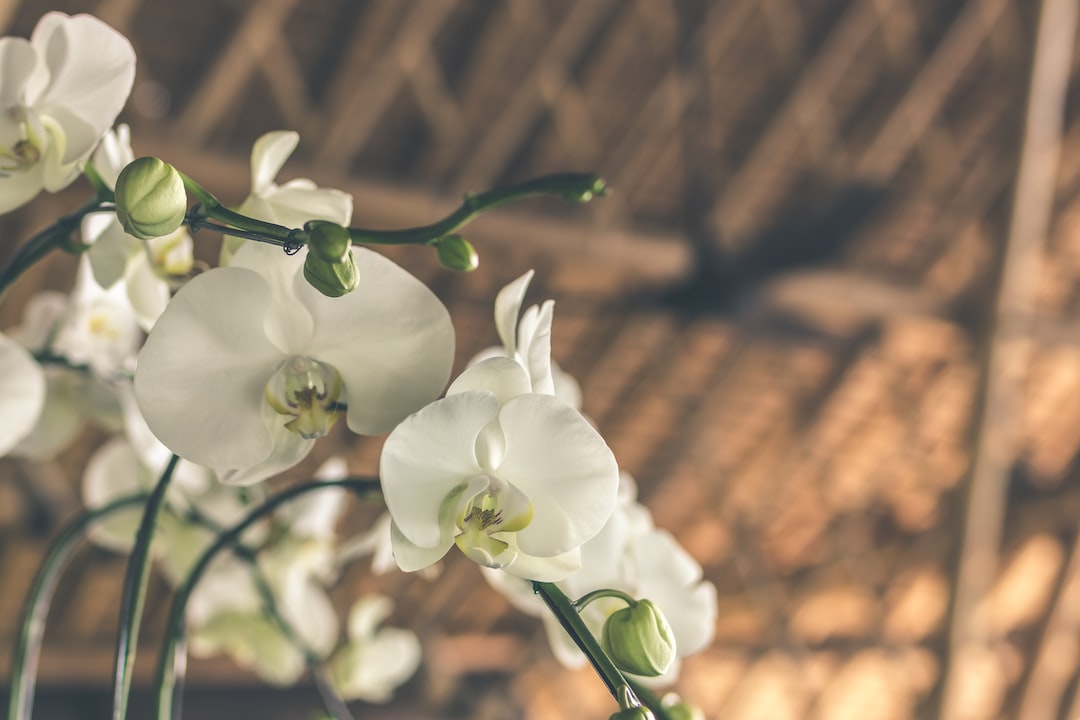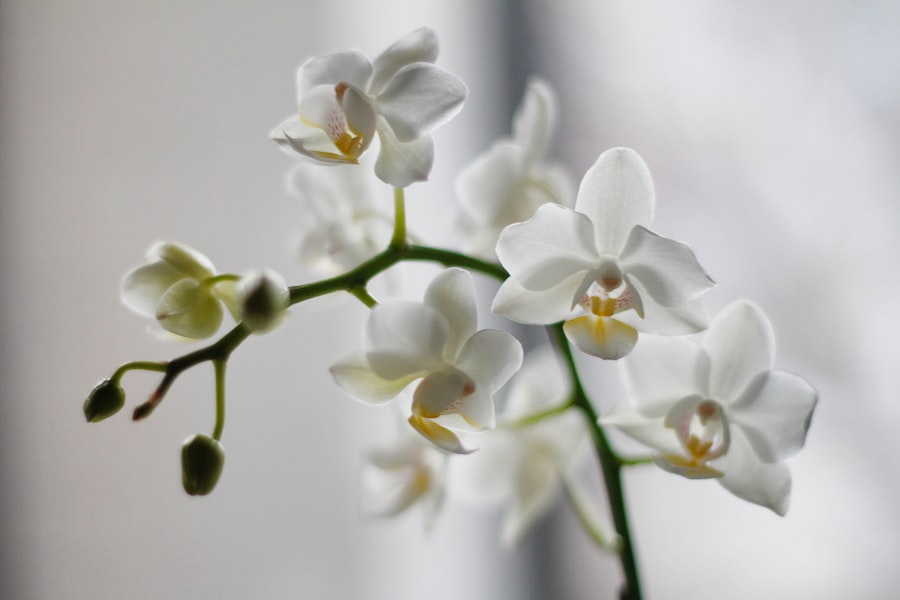Why Are My Orchid Blooms Falling Off? Understanding the Reasons Behind This Common Issue

Orchid bloom drop is a common problem that many orchid growers face. It can be frustrating to see your orchids lose their blooms prematurely, especially after putting in so much time and effort into their care. However, understanding the various factors that can contribute to bloom drop can help you better manage and prevent this issue. In this blog post, we will provide an overview of the natural causes, environmental factors, watering and fertilization, pests and diseases, overcrowding and repotting, stress and trauma, genetics and hybridization, and cultural practices that can affect orchid bloom quality.
Key Takeaways
- Orchid bloom drop is a common concern among growers.
- Understanding the life cycle of orchids can help identify natural causes of bloom drop.
- Environmental factors such as temperature, light, and humidity can impact orchid blooms.
- Proper watering and fertilization can help balance moisture and nutrient needs to avoid bloom drop.
- Identifying and treating pests and diseases is important for preventing orchid problems.
Natural Causes of Orchid Bloom Drop: Understanding the Life Cycle of Orchids
Orchids have a natural bloom cycle that includes a period of growth, blooming, and dormancy. Understanding this cycle is crucial for orchid growers as it can help them anticipate and manage bloom drop. During the growth phase, orchids focus on developing new leaves and roots rather than producing blooms. Once they have reached a certain level of maturity, they enter the blooming phase where they produce beautiful flowers. After blooming, orchids may enter a period of dormancy where they conserve energy and prepare for the next growth cycle.
During the dormancy phase, it is normal for orchids to shed their blooms. This is a natural part of their life cycle and should not be a cause for concern. However, if your orchid is dropping blooms outside of its normal dormancy period or if it is consistently dropping blooms prematurely, there may be other factors at play.
Environmental Factors: The Impact of Temperature, Light, and Humidity on Orchid Blooms
Orchids require specific environmental conditions to thrive, including temperature, light, and humidity. Changes in these factors can cause bloom drop. For example, if an orchid is exposed to extreme temperatures, such as cold drafts or direct sunlight, it may drop its blooms as a protective mechanism. Similarly, if an orchid is not receiving enough light or if it is exposed to too much light, it may also drop its blooms.
Humidity is another important factor to consider. Orchids are native to tropical regions where humidity levels are high. If the humidity in your growing area is too low, your orchids may struggle to retain their blooms. On the other hand, if the humidity is too high, it can create a breeding ground for pests and diseases, which can also lead to bloom drop.
Watering and Fertilization: Balancing Moisture and Nutrient Needs to Avoid Bloom Drop
| Watering and Fertilization Metrics | Values |
|---|---|
| Soil Moisture Level | Optimal: 50-75% |
| Frequency of Watering | Varies based on plant type and environmental conditions |
| Nutrient Requirements | Depends on plant type and growth stage |
| Fertilizer Application | Varies based on plant type and soil nutrient levels |
| Bloom Drop Prevention | Proper watering and fertilization to maintain optimal moisture and nutrient levels |
Proper watering and fertilization are essential for orchid health and can help prevent bloom drop. Orchids have specific moisture and nutrient needs that must be carefully balanced. Overwatering or under-fertilizing can cause problems for your orchids, including bloom drop.
When it comes to watering, it is important to remember that orchids do not like to sit in water. They prefer a well-draining growing medium that allows excess water to drain away. Overwatering can lead to root rot, which can cause stress and ultimately result in bloom drop. On the other hand, underwatering can cause dehydration and nutrient deficiencies, which can also lead to bloom drop.
Fertilization is another important aspect of orchid care. Orchids have specific nutrient requirements that must be met for healthy growth and blooming. However, it is important not to overdo it with fertilizers as this can lead to salt buildup in the growing medium, which can harm the roots and ultimately result in bloom drop. It is best to follow a regular fertilization schedule using a balanced orchid fertilizer and to flush the growing medium periodically to prevent salt buildup.
Pests and Diseases: Identifying and Treating Common Orchid Problems
Orchids are susceptible to a variety of pests and diseases that can cause bloom drop. Common pests that can affect orchids include aphids, mealybugs, spider mites, and scale insects. These pests feed on the sap of the orchid, causing stress and ultimately leading to bloom drop. It is important to regularly inspect your orchids for signs of pest infestation and to take appropriate measures to control and treat the problem.
In addition to pests, orchids can also be affected by various diseases, such as fungal and bacterial infections. These infections can weaken the plant and cause it to drop its blooms. Proper sanitation practices, such as sterilizing tools and pots, can help prevent the spread of diseases. If you suspect that your orchid has a disease, it is best to consult with a plant pathologist or orchid expert for proper diagnosis and treatment.
Overcrowding and Repotting: Ensuring Adequate Space and Proper Potting Techniques

Orchids require adequate space and proper potting techniques to avoid bloom drop. Overcrowding can lead to competition for resources, such as light and nutrients, which can cause stress and ultimately result in bloom drop. It is important to give your orchids enough space to grow and spread their roots.
Repotting is an essential part of orchid care, but it must be done correctly to avoid bloom drop. When repotting an orchid, it is important to use a well-draining growing medium that allows air circulation around the roots. Improper potting techniques, such as using a pot that is too large or packing the growing medium too tightly, can lead to root suffocation and stress, which can result in bloom drop.
Stress and Trauma: How Orchids Respond to Changes in Their Environment
Orchids can experience stress and trauma from changes in their environment, such as repotting or moving to a new location. These changes can disrupt their normal growth and blooming cycles, leading to bloom drop. It is important to minimize stress and trauma as much as possible by providing a stable and consistent environment for your orchids.
When repotting an orchid, it is best to do so when it is not in bloom or during its dormant period. This will minimize the stress on the plant and give it time to recover before entering its next growth cycle. Similarly, if you need to move your orchid to a new location, try to do so during a period of dormancy or when it is not in bloom.
Genetics and Hybridization: The Role of Breeders in Orchid Bloom Quality
Breeders play a significant role in orchid bloom quality through hybridization and selection. They carefully select parent plants with desirable traits, such as vibrant colors and long-lasting blooms, to create new hybrids. However, not all hybrids are created equal when it comes to bloom quality.
Some hybrids may be more prone to bloom drop due to their genetic makeup. It is important to research the specific hybrid you are growing and understand its unique needs and characteristics. By selecting healthy plants with strong genetics, you can increase the chances of having orchids with beautiful and long-lasting blooms.
Cultural Practices: Tips for Maintaining Healthy Orchids and Preventing Bloom Drop
There are many cultural practices that can help growers maintain healthy orchids and prevent bloom drop. Proper watering and fertilization are essential, as discussed earlier. In addition, regular inspection for pests and diseases, as well as prompt treatment when necessary, can help prevent stress and bloom drop.
Proper air circulation is also important for orchid health. Good air circulation helps prevent the buildup of moisture on the leaves, which can lead to fungal infections and bloom drop. Placing fans near your orchids or providing them with a well-ventilated growing area can help ensure good air circulation.
Finally, it is important to provide your orchids with the appropriate amount of light. Different orchid species have different light requirements, so it is important to research the specific needs of your orchids. In general, most orchids prefer bright, indirect light. Placing them near a window with filtered sunlight or using artificial grow lights can help provide the right amount of light for optimal bloom quality.
Orchid Bloom Drop is Manageable with Proper Care and Attention
Orchid bloom drop is a common problem, but it can be managed with proper care and attention. By understanding the natural causes, environmental factors, watering and fertilization, pests and diseases, overcrowding and repotting, stress and trauma, genetics and hybridization, and cultural practices that can affect orchid bloom quality, growers can maintain healthy and beautiful orchids. Remember to provide your orchids with the right environmental conditions, balance their moisture and nutrient needs, prevent and treat pests and diseases, give them adequate space and proper potting techniques, minimize stress and trauma, select healthy plants with strong genetics, and follow proper cultural practices. With these measures in place, you can enjoy vibrant and long-lasting blooms from your orchids.



